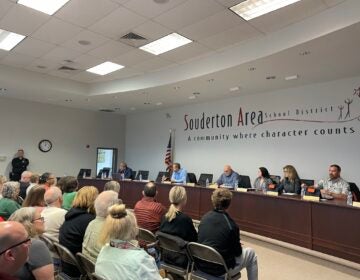Shorter days, asking parents for help: What the ‘teacher shortage’ looks like in 4 Pennsylvania districts
With the number of certified educators in Pennsylvania at “crisis” levels, school districts are facing stiff competition from one another for teachers and support staff.
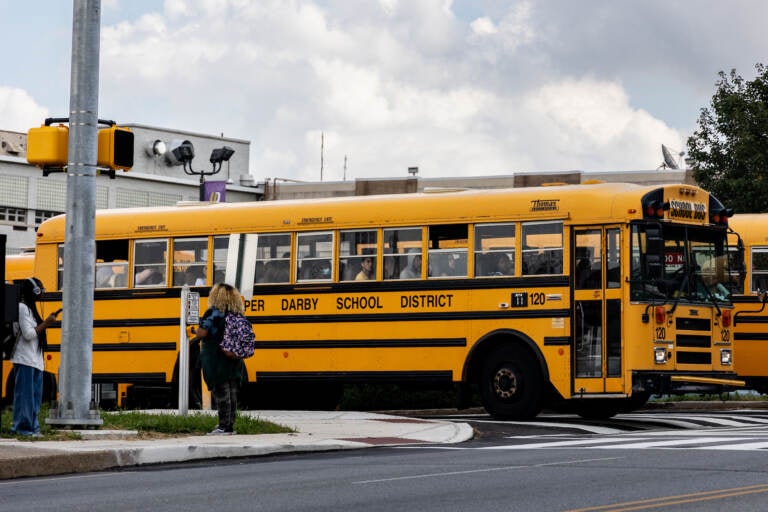
School buses exit Upper Darby High School’s parking lot on September 12, 2022. (Kimberly Paynter/WHYY)
Two weeks into the school year, Dan McGarry was still in the process of hiring teachers.
Upper Darby School District in Delaware County, where McGarry is superintendent, had more than 70 open teaching positions on paper, though about 40 of them had recommended candidates.
While some would consider those positions taken, McGarry didn’t.
“I tell my team, ‘Until they’re actually in the classroom, it’s not filled,’” he said.
Recently, they’d lost a new hire to another district.
“We’ve had somebody say they’re gonna take it, and then literally the next day someone offers them $4,000 or $5,000 more and we can’t match it,” he said. “We thought we had the job filled and it gets taken away from us.”
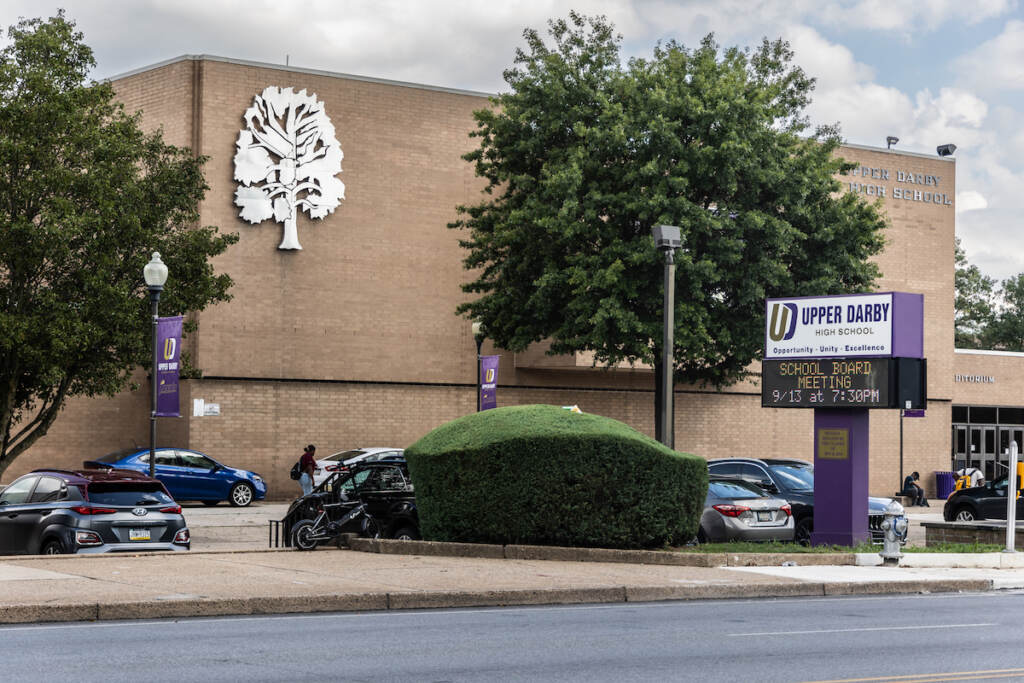
With the number of certified educators in Pennsylvania at “crisis” levels, according to state officials, district leaders like McGarry have faced stiff competition from other districts not just for teachers, but for school support staff like bus drivers, nurses, and paraprofessionals.
Just 6,000 new teachers were certified last year, down from about 20,000 a decade ago.
What’s unclear is how many teaching positions are empty since the state Department of Education does not track vacancies. But Ed Fuller, an associate professor of education at Pennsylvania State University, doesn’t think the teacher shortage is affecting all schools equally.
“In a lot of places, it really isn’t a disaster,” he said, explaining that the smaller pool of teachers has likely had a disproportionate impact on school districts that serve lower-income communities where teacher hiring and retention has always been more challenging.
“They get hurt the worst,” Fuller said. “When supply diminishes, now there’s fierce recruitment battles. They’re gonna lose out.”
Pennsylvania’s school funding formula — which is currently the subject of a lawsuit — relies heavily on local property taxes, which means individual districts can end up with widely varying amounts of money.
That means with teachers and support staff in such high demand, less wealthy districts, like Upper Darby, are more likely to be at a disadvantage when it comes to hiring.
Not only are teachers more likely to accept a higher-salaried job, many are more likely to want to work in schools with more resources, including newer buildings, Fuller said.
For this reason, and possibly others, districts across Pennsylvania are experiencing staff shortages to varying degrees that further exacerbate pre-existing inequities.
Understaffing leads to tough choices in Upper Darby
Upper Darby is a large suburban district, with more than 12,400 students. About 60% of students are considered low-income and more than 1,400 are learning English as their second language.
“I don’t think the crisis is being felt by everybody right now because they’re not as diverse, they’re not as complex as Upper Darby School District,” said McGarry, the superintendent.
Last spring, he asked the district’s board to cap the number of credits high school students can take at 28, citing long-standing staffing issues, and they agreed.
Not everyone was happy.
“I’m telling people, ‘We can’t operate that way anymore. We can’t afford it and we can’t find the people,’ and I’m the ogre destroying the community, but I’m not,” McGarry said last week.
His other possible solution to high school staffing issues also upset some parents when he announced it last spring: Paying for students to take certain classes at the local community college, including transportation and course materials.
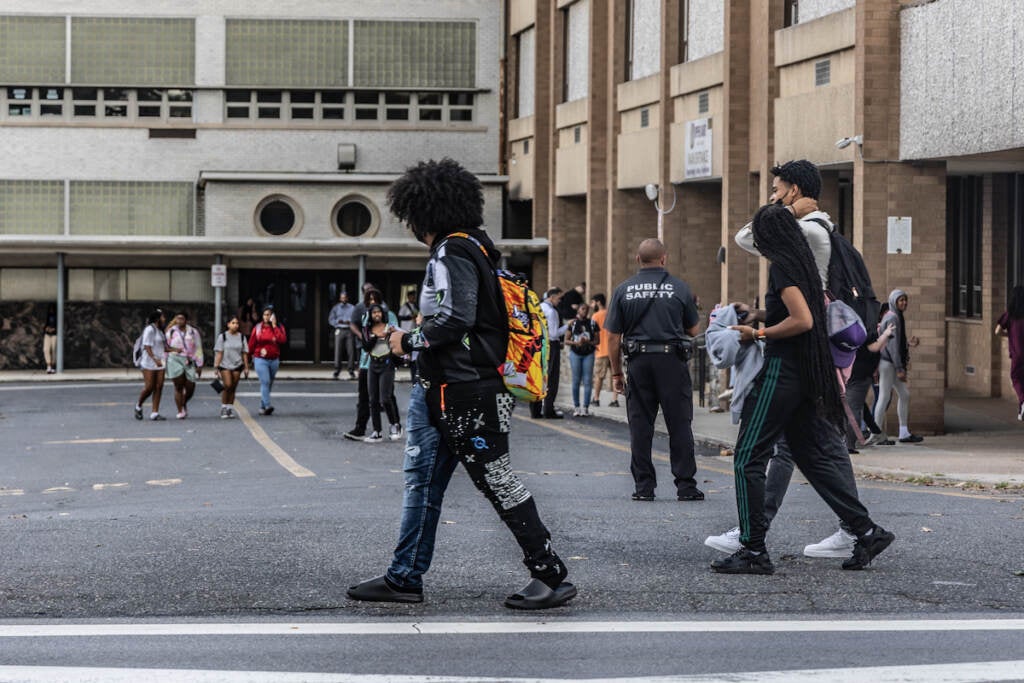
While the district still has multiple teacher vacancies at its 4,000-student high school, the community college option is off the table for this semester, McGarry said. Enough teachers agreed to teach additional classes, for which they’ll be compensated.
“That’s not the greatest long-term solution, because the burnout factor is pretty significant,” McGarry said.
And there’s another problem, too.
With so many teachers working packed schedules and a shortage of substitutes, if too many teachers call in sick, McGarry said, his only choice could be to close school. For now, 40 teacher absences at the district’s high schools or middle schools appears to be the tipping point.
“We’ve communicated that to our public. It’s a last resort to close them,” he said.
Shorter school days and no after-school activities for some students in Harrisburg
For students attending Rowland Academy, a middle school in Harrisburg, a shortage of teachers has meant the school’s 632 students spend less time in the classroom.
School leaders, facing 16 staff vacancies, announced in February that Rowland would move to a “compressed” schedule, trimming 80 minutes from the school day and dismissing early. They removed most humanities classes from the school day, providing them virtually instead. They also eliminated lunch periods and had students eat during one of their core classes.
Despite a summer of recruiting, the district had more bad news for families in August: Too many staff positions were still empty. The shortened school day would continue into the fall, this time without after-school activities.
“We can’t compare with other districts where your starting salary is $60,000,” said Eric Turman, superintendent of Harrisburg City Schools, last week. “It’s not something we can compete with. What you’re trying to sell individuals on is to come to Harrisburg.”
The starting salary for a teacher in Harrisburg this school year is $49,510, up from $47,634.
Harrisburg City Schools enroll nearly 6,700 students, the vast majority of whom identify as Black or Hispanic and low-income. Rowland Academy’s demographics are similar to the district overall, and it still has five classroom vacancies. There are 34 classroom vacancies district-wide.
Portia Slaughter, the school’s principal, said teacher turnover has long been a problem at Rowland. When she started at the school in the spring of 2020, only six teachers were considered veterans, having been in the building for more than five years.
Rowland’s staffing level has improved over the last few months and now is not much lower than the rest of the district’s, Turman said. He hopes the school will be able to return to a normal schedule by the end of the first quarter.
While the situation at Rowland hasn’t been ideal, Slaughter said she hopes people see it as an example of successful problem solving.
“It’s different, but what it does is still give face-to-face instruction with our scholars each and every day,” she said. “That education may not be the same but what we’re trying to do is ensure that we can still give them quality instruction as we continue to search for highly qualified staff.”
Bald Eagle holding on to departing teachers for as long as possible
Joseph Clapper, interim superintendent for Bald Eagle School District in Centre County, said the teacher shortage has made it necessary for school leaders to retain departing teachers for longer than usual.
Pennsylvania’s school code requires all certified employees to provide 60 days notice of their intent to leave. Clapper and other superintendents said while it used to be rare for districts to hold onto teachers for the full 60 days, now it’s become common practice.
“We have to deliver quality teaching and instruction and services to our kids,” Clapper said. “If that means holding teachers before they leave for another pasture, that’s what we will do.”
Clapper said this phenomenon — of districts holding teachers while they look for a replacement in a tight labor market — creates a “checkerboard effect,” impacting multiple school districts and ultimately results in more staff turnover mid-year.
For a small rural district, like Bald Eagle, high teacher demand has made it hard to attract, hire, and retain qualified candidates, Clapper said.
“There’s quantity and quality and you want both in the hiring process,” he said. “Right now, the quantity piece is clearly missing.”
While Bald Eagle and other small rural districts are used to losing teachers to larger, more affluent schools, they’re seeing it more frequently this year, with the post-pandemic hiring boom and a scarcity of certified teachers.
Clapper said he also believes the district is missing out on new college graduates who can now afford to be more selective.
“They can be because there are a vast array of openings and limited candidates,” he said. “That’s the new reality for us.”
In some cases, 60 days hasn’t been enough time for Clapper to hire a teacher’s replacement.
A few weeks before the start of the school year, Bald Eagle was looking for an elementary school counselor and several special education teachers. The positions have since been filled, but at the time, the counseling vacancy would have meant having an existing counselor “spread himself thin” to cover more than 300 students across three schools.
“When you’re small and rural, each building is 15 or 20 miles apart,” Clapper said. “You’re not in the building with kids for two to three days because you’re on a rotation. So kids get less service.”
Central Bucks asking parents to become paraprofessionals
With fewer than 10 classroom vacancies, Central Bucks School District in Bucks County appears to be in better shape than many other districts in the state.
“Those openings are in the most difficult areas,” said Abe Lucabaugh, the district’s superintendent. For example, they’re still looking for a teacher to work with students who are deaf or hearing impaired, as well as multiple Latin instructors.
Central Bucks is one of Pennsylvania’s biggest districts with roughly 17,600 students and 3,400 employees.

With nearly $1.9 billion assessed in taxable property, it’s also one of the state’s more financially well-off systems despite having one of the lowest property tax rates in the county.
The starting salary for the district’s more than 1,300 teachers recently increased to $49,730 for the 2022-23 school year, with more experienced teachers making up to $116,586.
While Central Buck’s base salary is only a few hundred dollars higher than Harrisburg’s, there’s much more room for growth. In Harrisburg, the most a teacher can earn is $82,774.
Lucabaugh said when it comes to staffing concerns, he’s more focused on the district’s shortage of support staff, including bus drivers, cafeteria workers, and paraprofessionals.
About 14% of students in Central Bucks receive special education services, some of which are provided by personal care or special education assistants.
While the district still has openings for these positions, Lucabaugh said that doesn’t mean students aren’t actively receiving their federally mandated services.
“We’ve been able to do it to this date, but it’s definitely been more challenging than years past,” he said, explaining that some employees had been reassigned to “strategically” cover gaps.
Central Bucks administrators made an “important appeal” to parents this week, asking them to apply for the district’s open support roles. “These positions offer competitive pay, excellent hours, and great benefits for those eligible,” the email said.
Pay for paraprofessionals starts at $16.40 an hour with benefits for full-time employees.
“We’re facing economic competition from the private sector that we’ve never experienced before,” Lucabaugh added. “Retail and restaurants are significantly increasing their wages to attract employees. That’s a new reality that we have to take into account.”
Details of the state teacher shortage largely unknown
Ed Fuller, the researcher at Pennsylvania State University, said while state certification data provides clear examples of shortages in some specific areas, mainly special education, the extent of the state’s teacher shortage is still unknown — mainly because vacancy data doesn’t exist at the state level.
Fuller said the state needs to “throw everything” at the problem to fix it, but the approach still needs to be targeted.
“The better data we have the more fully we can understand what the extent of the issue is and then craft policies that directly address our real issues, instead of just saying, ‘There’s this gigantic problem, let’s just throw a bunch of money at it,’” he said.
Many other states don’t track vacancy rates at the state and district levels either, leading to national confusion concerning the extent of the teacher shortage.
Like other states, part of the Pennsylvania Department of Education’s plan to address current school staffing challenges includes gathering data on district-level vacancies, the department said.
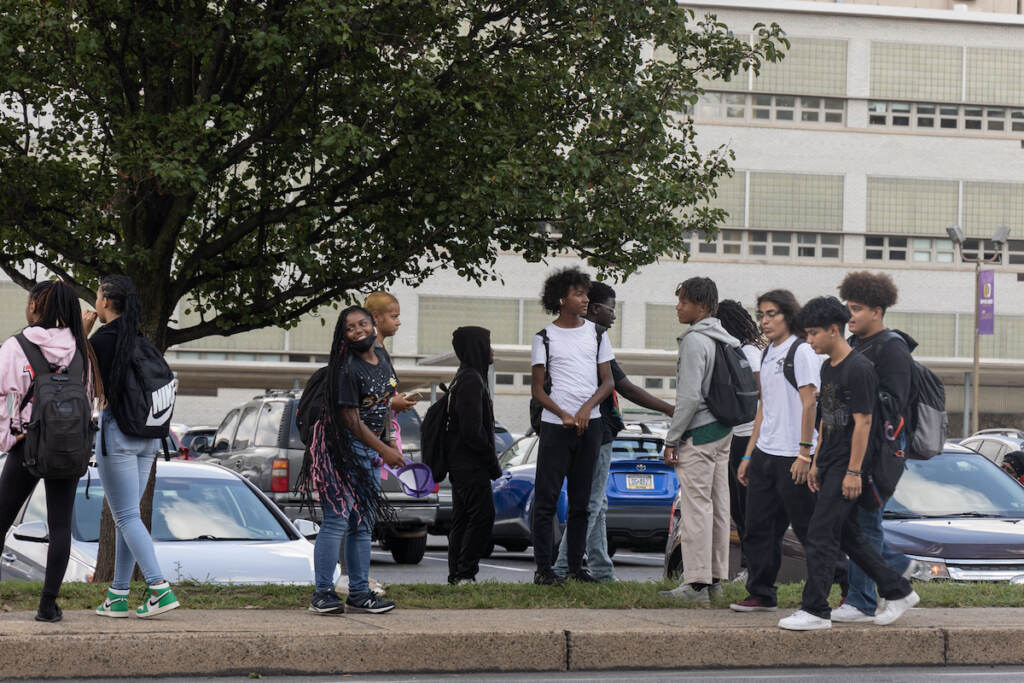
For Fuller, who’s been asking for this kind of data for over a decade, the announcement was welcome news. He said if the state really wants to tackle the issue, they need to collect the right kind of data right away.
“Just saying ‘we have a crisis teacher shortage’ is not accurate,” Fuller said. “If you don’t have a nuanced response that directly addresses your issues, it’s not an efficient response and it’s not as effective either.”

Get daily updates from WHYY News!
WHYY is your source for fact-based, in-depth journalism and information. As a nonprofit organization, we rely on financial support from readers like you. Please give today.








